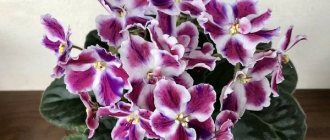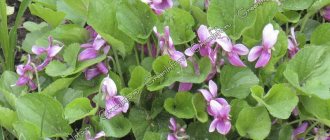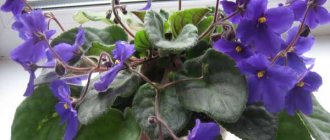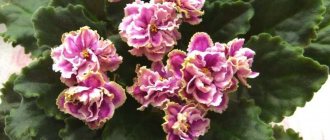The world of violets is very colorful and amazing. A special class is varietal Saintpaulias, the care of which requires some knowledge.
Breeders are creating more and more new species, but only a few deserve recognition among collectors. This article is dedicated to the PT-Foxtrot . Here you will find detailed photos and descriptions of the variety and learn about the features of growing it at home.
Violet PT-Foxtrot (T. Pugacheva)
Breeder from Kursk Tatyana Pugacheva has been doing what she loves for many years. Breeding a new variety of violet is not easy - pollination, germination, testing of varietal characteristics. PT-Foxtrot was created in 2015 , and already in 2016 it was rapidly spreading among collectors.
Large star-shaped flowers are decorated with pink and white fantasy in the form of streams and strokes . The leaves are dark green and the flower stalks are quite large and hold large flowers.
A fairly sporty variety - in almost 30 percent of cases it thrives in a different way.
Violet EK-Orange Slices (E. Korshunova)
Colorful violet EK-Orange Slices.
The author of the unusually elegant violet is Elena Vasilievna Korshunova , a breeder from Tolyatti. This amazing Saintpaulia has no analogues. The beauty got its name from the orange color of the petals and their unusual shape, reminiscent of citrus slices.
Meet the Uzambara violet EK-Orange Slices:
- Family - Gesneriaceae;
- Genus – Saintpaulia hybrid;
- Flowers:
- Notched;
- Semi-double;
- Size 5-6 cm;
- Pink-orange color, with spreading crimson and deep yellow stains.
Large;
The center of the flowers is bright, orange-yellow. The petals curve inward in an original way , making them look like orange slices. The underside of the flower has a yellow color. Peduncles are strong, strong;
- Fleshy;
- Exhibition;
Features of care
So, in the case of varietal violets, it is important to know certain care rules . Having created the necessary conditions, you can regularly admire the lush head of flowers.
Soil selection
The most important point is the composition of the soil . Saintpaulias do not tolerate heavy substrates - the root system begins to rot in them.
The best option is high-moor peat with perlite or foam balls in a ratio of 70 to 30 . Vermiculite, contrary to advice on forums, does not need to be added - it has a moisture-retaining property, which can lead to rotting.
If we are talking about wick irrigation, the ratio of peat and ripper changes to 50 to 40, respectively.
Lighting
This particular variety does not tolerate a lack of light . In conditions of insufficient lighting, PT-Foxtrot begins to stretch out the leaves, the flowers become smaller or their number becomes negligible.
The variety is suitable for shelving or for a south-eastern window sill. In this case, direct sunlight should not fall on the plant, otherwise dry spots may appear.
Watering
Watering is done very carefully:
- as soon as the soil dries 1 centimeter, you can carefully spill the container with a small amount of water;
- if the plant is a little dry, add water in small portions, literally drop by drop;
- If the violet is flooded, it is necessary to urgently change the soil.
You can see problems with watering by drooping leaves or darkened cuttings.
Air humidity
As for humidity, only excessive dryness harms the flower . If dry spots or cracks begin to appear on the leaves, you should place a jug of water or a humidifier nearby.
To increase humidity, use a tray with wet expanded clay.
Top dressing
Fertilizer is applied strictly according to the instructions on the package ; it is advisable not to overfeed Saintpaulia with nitrogen fertilizers - in this case, you may not get flowers.
Content temperature
The variety does not tolerate heat well - the flowers become smaller, the fancy pattern practically disappears. The optimal temperature is from 15 to 22 degrees.
Plant hygiene
Every violet should be washed periodically. Yes, yes, Saintpaulia responds well to bathing! It is only important not to fill the soil and leave the flower in a dark place without drafts until it dries completely. Carefully rinse each leaf under running water, slightly tilting the violet.
Important! When pests appear, such as ticks or scale insects, it is best to use industrial products - they are much more effective than traditional methods. After applying chemicals, the violet will need to be washed!
Contents in room culture
For varietal specimens, the standard principles of caring for most violets of the genus :
- Placement on western or eastern window sills is considered ideal; the northern window requires mandatory lighting, the southern window needs light shading;
- Watering should be carried out in measured portions, only after the upper part of the substrate has slightly dried;
- Fertilize only on demand;
- Lighting should be long-lasting, daylight, diffuse spectrum;
- The room temperature is within +20 + 24°C;
- Humidity can be increased in any way, except by spraying the violet itself;
- Suitable soil is nutritious, well aerated, permeable; with mandatory drainage;
- Transplant except in special cases, it is better to carry out using gentle transshipment.
The presented Saintpaulia must be properly cared for.
Transplantation and rejuvenation
After flowering or if the plant ages, it needs to be replanted. The pot should be small; violets grow well in 100 ml plastic cups. For beauty, it can be placed in a flowerpot.
So, a regular transplant only involves replacing the soil. But the bare trunk needs to be cut from the bottom , like a carrot, stripping the trunk to the green base. The lower leaves need to be torn off.
After this, the plant is planted in light soil, but it is important not to bury the growing point too deep. If leaf turgor is lost, it is better to place the plant in a greenhouse.
If you decide to keep your violet on wick irrigation , then the composition of the soil also changes - 40 to 60 peat and cultivators. Make sure that the plant was planted on a small hill. You cannot use threads made from natural materials - they will rot.
Interesting fact
At almost every AVSA exhibition, American hobbyists grow “Russian varieties” , which they really like. And many of them believe that these are all Eugene’s violets. This is explained by the fact that the names of breeders are not written on the labels during the exhibition, and Evgeniy is the only Russian who attends such events.
He often has to dissuade his American colleagues and explain that besides him, there are about twenty breeders who every year develop dozens of new varieties of violets and demonstrate them at exhibitions in the “House of Violets.”
The varieties discussed are a complete reflection of the breeder Evgeny Arkhipov. Strong stems, less whimsicality compared to other varieties of violets, as well as an extraordinary palette of colors that surprises even the most experienced breeder’s colleagues. For violet lovers, the main joy is the opportunity to purchase leaves grown by Evgeniy himself at the “Violet House”.
Reproduction
How to propagate violets? There are several ways - with a leaf or a stepson.
In the first case, you need a healthy cutting from the middle row . Never take leaves that are too small or too large! The cutting is cut at an angle of 45 degrees with a sharp blade and then placed in a plastic cup with soil. There is another way - wait for rooting in water.
As practice shows, the method with earth ends successfully in 90 percent of cases . The main thing is not to flood the soil.
After planting, the leaf is watered from a pipette and placed in a greenhouse. Enough lighting and warmth - within a couple of weeks the leaf will take root, and in a month or two it will produce babies.
The stepchildren are simply separated from the mother plant and also planted in light soil. It can take up to 10 months from planting the cutting to the first flowering.
Stepson.
IMPORTANT! The PT-Foxtrot variety is a rather slow-developing variety.
Top 10 most popular varieties
EK-Green Apples
A special feature of this variety is its densely double flowers with light green outer petals . The center of the flower is blue.
The leaves are deep green. When kept in cool conditions, the flower shows its shades more vividly.
PC-Green Corals
Features simple blue-white stars bordered with bright green fringe.
The foliage of this violet variety is ruffled, shiny, and medium green. Large leaves often have a gnarled shape . Due to the dense, twisted foliage, the rosette cannot acquire a beautiful shape.
The flowers are dense and have an unusual ultramarine color. A bluish-colored border surrounds the edges of the petals. The shade of the flower petals and border can be of different saturation.
The process of blooming buds takes a long time, some of them do not have time to fully bloom. Blooming flowers last for about a month.
Attention! The plant is not distinguished by frequent and lush flowering. Next to very large leaves, small flowers look lonely.
AB-Cupid
A showy variety with white single or semi-double pansies , with a slight pinkish tint and a bright green ruffled edge.
The foliage is quite large, shiny, bubbly, and medium green. a pink tint on the white petals of the flower appears in conditions of elevated temperature.
Violet is characterized by abundant and long-lasting flowering. Many small flowers on strong, stable peduncles cover the plant with a “cap”.
This variety is distinguished by its unpretentiousness and fertility.
Fronzen in Time
A surprisingly delicate variety that has white cupped flowers resembling stars, which are bordered by a rich green rim.
The plant is valued for its long flowering . The flowers sometimes take on a lavender color.
The foliage is variegated green and white.
EK-Malachite orchid
Its large double flowers have a rich cherry color with a wide green border around the edges.
Under the influence of low ambient temperatures, the color of the violet becomes almost completely green , leaving only the cherry middle.
The leaves of the rosette are distinguished by their pointed shape. Flowering duration is about 3 months . The buds are usually collected in bouquets.
The variety is characterized by intensive growth and unpretentiousness.
LE-Green Rose
The flowers of this variety resemble pansies, are painted in a soft pink color, and the edges of the petals are framed with a green fringe. The foliage has a wavy shape and a glossy shine.
The border is green in just opening buds , then, as the flower opens, it becomes yellow, and then completely loses color, becoming white.
Bouquet blossom . Does not have a long flowering period. Fast growing variety.
Green Horizon
The flowers of this variety of Saintpaulia are double stars of white color , with wide stripes of green along the edges of the petals. The foliage is medium green.
The saturation of green color in the petals of the bud manifests itself with the age of the rosette - the older it is, the larger and richer the flowers look.
Important! This green-white violet boasts abundant and long-lasting blooms, a fast growth rate and ease of propagation.
Allegro Pink Pistachio
A chic semi-miniature variety , distinguished by double herbaceous green rosettes bordered by a crimson-red frill.
The foliage is light green in color, has a shiny surface and an elongated shape.
Flowering is almost continuous . A unique, incomparable variety.
RS-Miracle Lily of the Valley
The flowers of this variety of violet delight with their simplicity and tenderness.
They have the shape of a pink bell with a light green fringe along the edges of the petals. The bud never opens completely , hence the similarity with lily of the valley.
The foliage is standard, light green. Flowering is long and abundant.
AB-Frog
The flower is similar to a pansy, semi-double, ruffled, blue-white with a blue edge and green upper petals.
The leaves have a round shape and jagged edges. The combination of colors in a bud looks very impressive.
Flowering is abundant and long lasting.
Features of development
As mentioned above, PT-Foxtrot is a fairly sporty variety. Moreover, collectors note that changes in varietal characteristics sometimes do not depend on environmental conditions.
During the period of bud formation, it is ideal to create a temperature difference for the flower. For example, place the plant on a warm balcony at night or periodically turn on the air conditioner.
Another important feature is the fairly spreading outlet. It is important to focus on potash fertilizers for full flowering . A large amount of nitrogen leads to lengthening of cuttings and enlargement of leaves.
The PT-Foxtrot has a fairly spreading rosette.
If, after all, the plant begins to bloom not according to its variety, do not be discouraged - such flowers are no less beautiful.
Reviews
Natalia. “Foxtrot was given to me by a friend on the violet growers forum, in the form of her stepson. I don’t bother too much and plant all the violets in purchased soil, adding a little perlite. The plant began to bloom within a couple of months, growing by leaps and bounds. But alas, I ended up with sports. I’m growing a new specimen from a different leaf.”
Catherine. “Personally, the variety seemed very problematic to me. Sometimes the leaves stretch out, sometimes the flowers are small, sometimes they thrive in sports. Apparently, my conditions did not suit him. I gave it to a friend, she blooms tirelessly.”
Elena. “I really liked Foxtrot. Surprisingly, it grows on a window, without additional lighting, without any problems. I generally don’t like capricious varieties, I get rid of them quickly.”
Marina. “I received this violet as a gift with my order. Since the colors did not inspire me at all, I simply planted the leaf in the ground, without any greenhouses. Imagine my surprise when Foxtrot gave birth to babies before anyone else! I currently have 2 plants grown from the same leaf. But they bloom differently - one bush is white, and the other is a varietal one.”
Antonina. “I didn’t like the violet - the flowers most often do not have a fancy color, the cuttings are elongated. I couldn’t determine the optimal watering - I constantly dried it out, then flooded it, while trying different frequencies and amounts of water. I gave it to a friend."
About breeder Evgeny Arkhipov
E. Arkhipov began to engage in breeding back in 1999. In the same year, pollination occurred, as a result of which new species were born: “Charming”, “Sea Myth”, “Evening Stars”. Evgeny Arkhipov believes that these varieties of violets were a strategic mistake, since they had simple flowers, without double covering and had a standard star-shaped shape, although the quality of peduncles and flowering were good.
Attention : Since 2006, there has been a rapid leap in his career - Evgeniy managed to create varieties with a unique color. To this day, these violets have no analogues. These included: “Armageddon”, “Cupid”, “Vesuvius Elite”, “Sagittarius Elite”.
Next, we will tell you about the most interesting varieties bred by E. Arkhipov - “Egorka Molodets”, “Aquarius” and others, we will give a brief description and photo of each of them.











